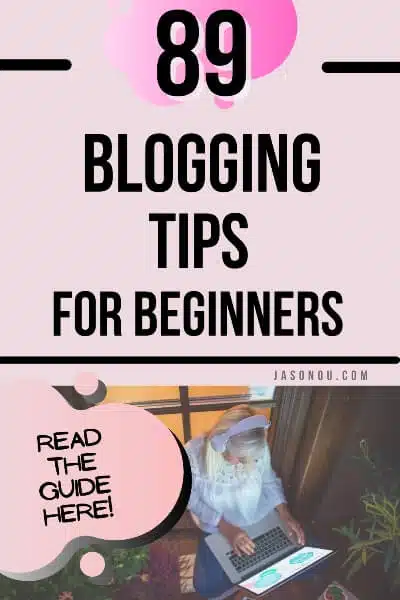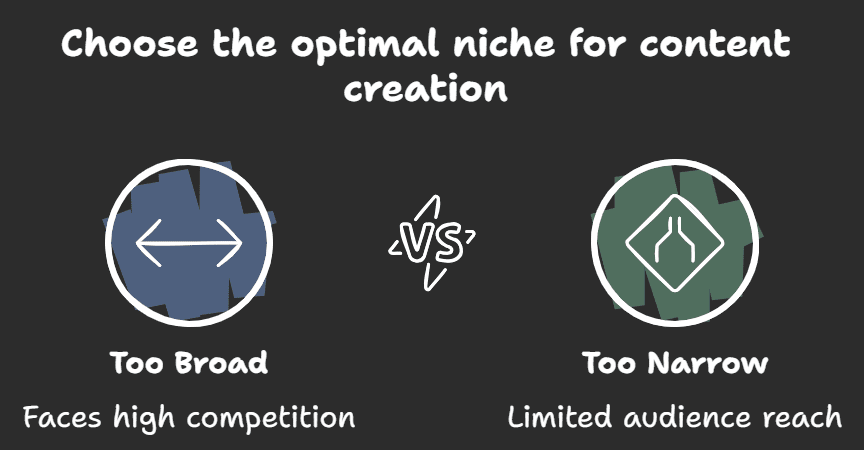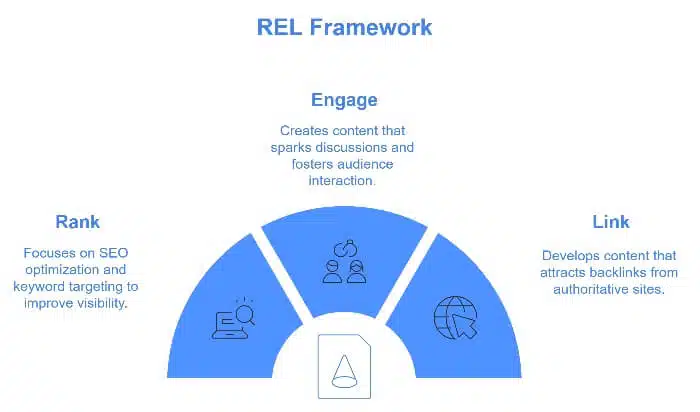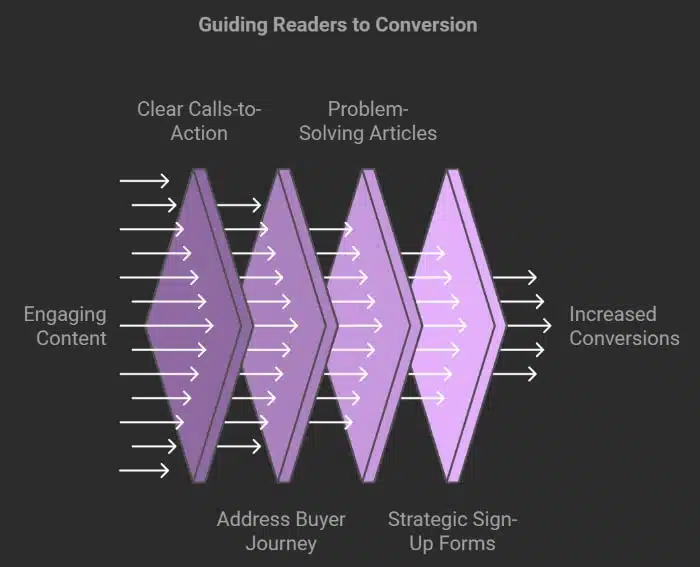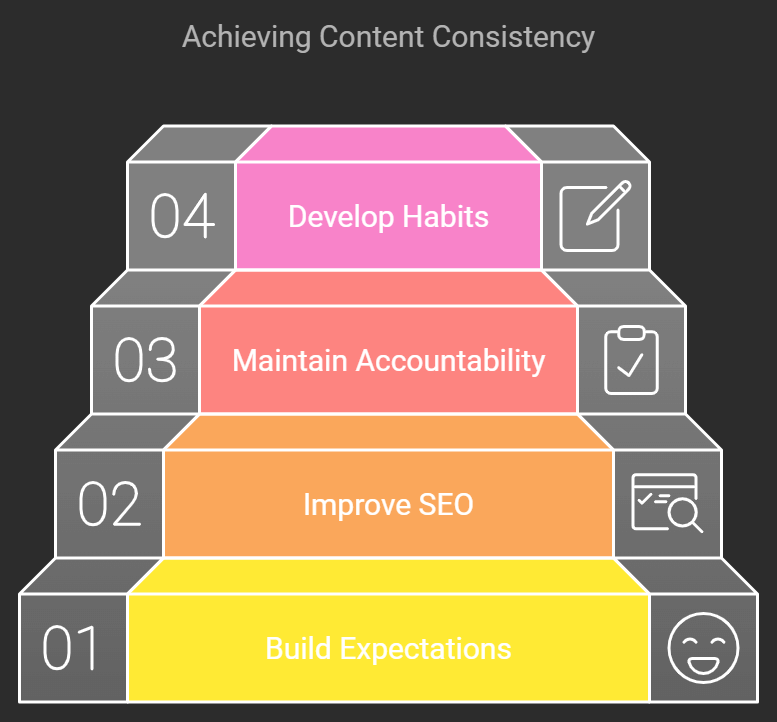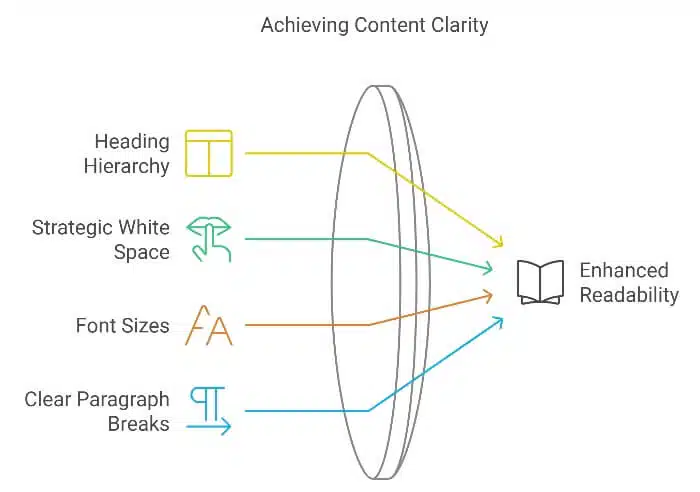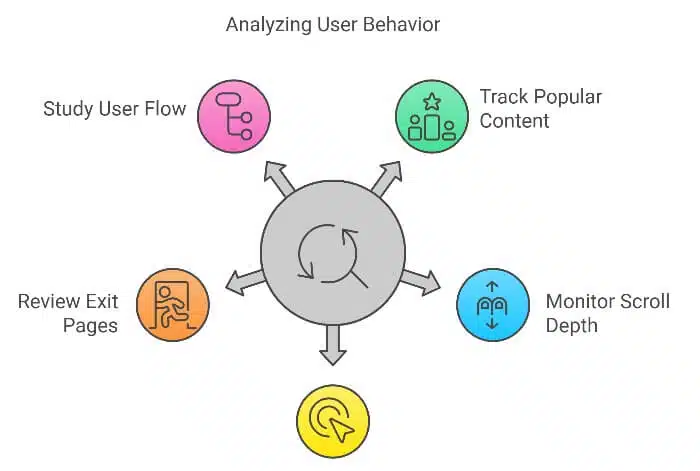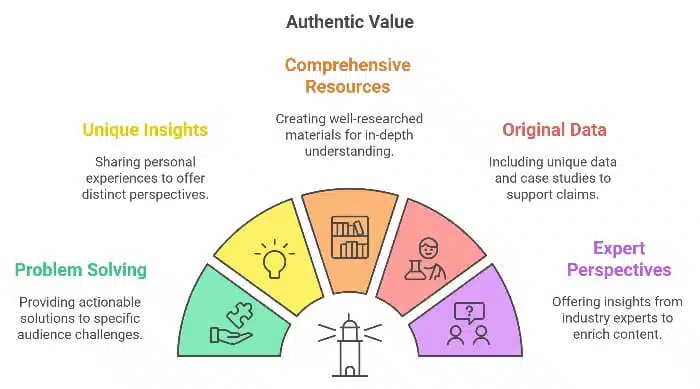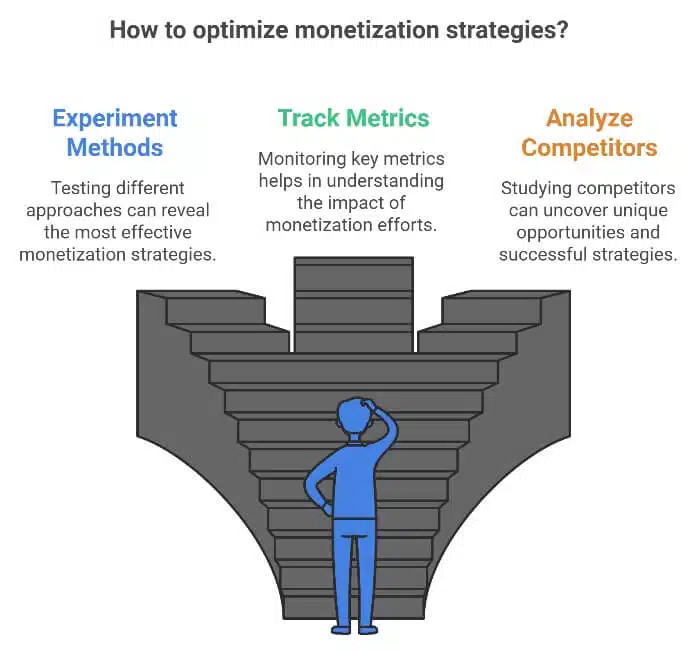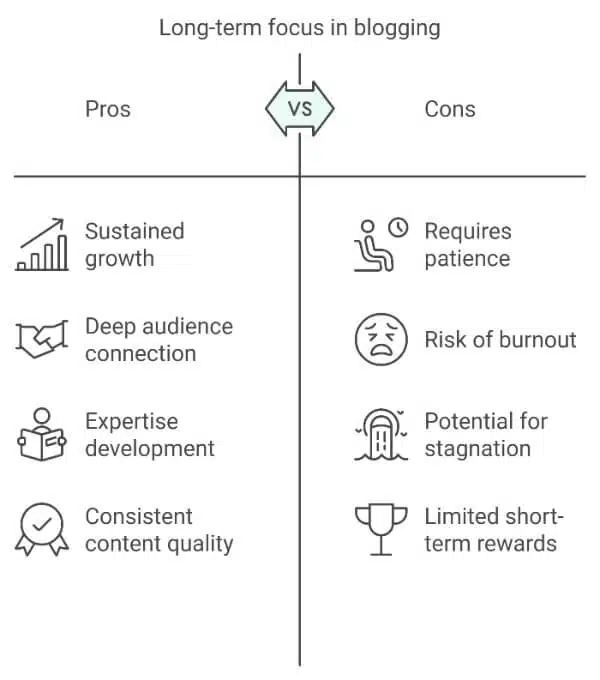Starting a blog can feel overwhelming.
You might be staring at your screen, wondering what to write about or if anyone will read your posts.
I know exactly how that feels – I've been there too! These blogging tips for new bloggers will help make your journey easier.
I've put together 89 tips that actually work.
I'll show you step by step how to pick your topic, write great posts, and even make money from your blog.
Let's make your blogging dreams come true with these proven tips that work in the real world.
Key Takeaways
- Pick a topic you know well and love, but make sure other people want to read about it too
- Write posts that help solve your readers' problems instead of trying to be perfect
- Use clear headings and short paragraphs to make your posts easy to read
- Get more readers by writing guest posts for other blogs and using social media wisely
- Make money from your blog in different ways, like ads and selling helpful products
Ready to Learn How to Start a Thriving Blog? Click Here Now
89 Blogging Tips for New Bloggers
Save/Pin the image below👇because I often update my posts. So stay informed with this blog “Blogging Tips for Beginners” and save it.
I. Niche Selection (Tips 1-15)
1. Find your sweet spot at the intersection of knowledge, passion, and profitability
Pick a blog topic that brings together three things:
- What you know well
- What you love doing
- What people want to read about and pay for
Think about stuff you’re good at and enjoy talking about.
Make sure other people are interested in learning about it too.
Here’s an example:
Let’s say you know a lot about healthy eating and love cooking Mediterranean food.
If you see lots of people asking for help with planning their meals, that’s perfect!
You can write about something you know and love, while helping others who need it.
When you pick a topic like this, you’ll enjoy writing about it for a long time, and your readers will trust what you say.
2. Avoid overly broad niches (like “health and fitness”)
Big topics are really hard for new bloggers to write about.
Think about topics like “health and fitness” or “money tips.”
Big companies with lots of money already own these topics.
They have huge teams and better websites than you can make right now.
When too many people write about the same thing, it’s hard to get noticed.
Your blog posts won’t show up when people search online.
Instead, pick a smaller part of these big topics.
For example, instead of “fitness,” write about “exercise tips for busy moms.”
This way, you can become known as an expert in your small topic.
When you focus on something smaller, you can write better posts and find readers who really want your help.
3. Choose specific but not too narrow topics
You need to find the right balance for your blog topic.
Pick something that’s not too big or too small.
It should interest specific readers but give you lots to write about.
Here’s what I mean:
Don’t write about “cooking” – that’s way too big!
And don’t write about something super tiny like “vegan desserts for diabetic children.”
Instead, try something like “Mediterranean diet meal prep” or “keto baking for beginners.”
When you find this middle ground, you’ll get the right number of readers and be seen as someone who knows what they’re talking about.
4. Use the BBQ chicken recipes approach
This concept illustrates the ideal niche specificity perfectly:
- Too broad: “recipes” (millions of competitors)
- Too narrow: “grilled lemon-herb chicken thighs” (limited audience)
- Just right: “BBQ chicken recipes” (specific yet broad enough)
5. Check Google ads to verify commercial viability
Before committing to your niche, search for your main keywords and analyze the advertising landscape.
If businesses are actively spending money on ads in your niche, it indicates strong profit potential.
For example, finance-related keywords often have high advertising costs, suggesting significant monetization opportunities.
6. Research audience pain points
Understanding your target audience’s challenges is crucial for blog success.
Visit forums, social media groups, and Q&A sites where your potential readers gather.
Look for recurring questions, frustrations, and problems they’re trying to solve.
Create a spreadsheet to track these pain points and use them to guide your content creation.
This research will help you create content that genuinely addresses your audience’s needs.
7. Analyze competition levels
Study successful blogs in your niche to understand the competitive landscape.
Look at their content quality, posting frequency, and engagement levels.
Note their strengths and weaknesses, and identify gaps in their coverage that you could fill.
This analysis helps you understand what works in your niche and how you can differentiate yourself.
8. Test market demand
Before fully committing to your niche, verify there’s sufficient interest.
Use tools like Google Trends, keyword research platforms, and social media analytics to gauge potential audience size.
Look for steady or growing search volumes and active online communities.
This research helps ensure you’re entering a viable market with sustainable growth potential.
9. Verify profitability potential
Before fully committing to your niche, evaluate multiple revenue streams.
Look for successful bloggers in your space and analyze how they monetize their content.
Consider potential income sources like affiliate marketing, digital products, coaching, or sponsored content.
Research industry-standard rates and calculate potential earnings.
This verification step ensures your blog has sustainable income potential.
(Need more help? Here’s an in-depth guide on How to Choose a Profitable Blog Niche)
10. Define unique selling proposition
Your USP sets you apart from other blogs in your niche.
Identify what makes your perspective, experience, or approach different.
Perhaps you’re a certified expert, have unique life experiences, or offer a fresh angle on common topics.
This differentiation helps attract and retain readers who resonate with your specific viewpoint.
11. Map out sub-topics
Create a comprehensive content structure by identifying main categories and related subtopics.
This organization helps you:
- Plan content systematically
- Maintain focus within your niche
- Create content clusters
- Establish topical authority
Your content map should cover both broad themes and specific details within your niche.
12. Identify target audience demographics
Build detailed reader personas including:
- Age range and location
- Income and education levels
- Interests and hobbies
- Pain points and challenges
- Online behavior patterns
Understanding these demographics helps create more targeted, relevant content.
13. Research keyword opportunities
Use SEO tools to find valuable search terms that:
- Have decent monthly search volume
- Show reasonable competition levels
- Indicate clear user intent
- Offer potential for ranking
Focus on long-tail keywords that are easier to rank for as a new blogger.
14. Evaluate monetization potential
Assess various income possibilities:
- Affiliate marketing opportunities
- Digital product creation
- Coaching or consulting
- Advertising potential
- Sponsored content options
Look for niches with multiple monetization paths to ensure sustainable income.
15. Plan content categories
Organize your blog structure with:
- Main topic areas
- Related subcategories
- Content types and formats
- Publishing frequency guidelines
This framework ensures consistent, organized content delivery that serves your audience effectively.
II. Content Strategy & Framework (Tips 16-30)
16. Implement the REL Framework (Rank)
The REL Framework focuses on three key objectives: Rank, Engage, and Link.
Every piece of content you create should serve at least one of these purposes.
For ranking, focus on SEO optimization and keyword targeting.
For engagement, create content that sparks discussions.
For linking, develop content worthy of backlinks from other authoritative sites.
17. Focus on Engagement strategies
Create content that encourages reader interaction through:
- Strategic questions at the end of posts
- Interactive elements like polls and quizzes
- Compelling calls-to-action
- Response-worthy content
Engage with comments promptly and foster meaningful discussions to build community.
18. Develop Link building plans
Create a systematic approach to earning quality backlinks:
- Develop linkable assets (original research, case studies)
- Build relationships with industry influencers
- Guest post on relevant blogs
- Create shareable infographics
Focus on earning natural, high-quality links rather than quantity.
19. Create conversion-focused content
Design content that guides readers toward specific actions:
- Clear calls-to-action throughout posts
- Content addressing different buyer journey stages
- Problem-solving articles that lead to solutions
- Put your sign-up forms in the right places and use headlines that grab attention.
Here’s where to put your sign-up forms:
- At the end of blog posts
- In your sidebar
- As a pop-up after people read for a while
- At the top of your page
Write headlines that show you understand what your readers need help with. For example:
- “Tired of burning your cookies? Get our free baking guide”
- “Want to start a blog but feeling lost? Join our free course”
- “Get our simple tips to fix your garden problems”
Remember to keep your forms simple. Just ask for their name and email.
Make your “Sign Up” button stand out with bright colors.
20. Expand reach systematically
Develop a strategic plan to grow your blog’s reach through multiple channels:
- Social media presence on relevant platforms
- Pinterest marketing (my favorite)
- Email list building
- Guest posting opportunities
- Collaboration with other bloggers
- Community engagement
Create a systematic approach to expanding your audience while maintaining content quality.
21. Plan content series
Develop themed content series that keep readers coming back for more:
- Multi-part tutorials
- Weekly features
- Monthly challenges
- Seasonal content
When you post regularly, your readers know when to expect new content and get excited to read more.
22. Build content clusters
Create interconnected content that establishes topical authority:
- Core topic (pillar content)
- Related subtopics
- Supporting articles
- Internal linking structure
This strategy improves SEO and provides comprehensive value to readers.
23. Develop cornerstone content
Create comprehensive, evergreen content that serves as the foundation of your blog:
- In-depth guides
- Ultimate resources
- Definitive how-tos
- Complete tutorials
These pieces establish your expertise and attract consistent traffic.
24. Create content pillars
Develop comprehensive, foundational content pieces that:
- Cover core topics extensively
- Support multiple related articles
- Establish topical authority
- Drive consistent traffic
These main posts are like the building blocks of your blog.
They show readers that you really know what you’re talking about in your chosen topic.
25. Map reader journey
Create a clear path for readers to follow from discovery to conversion:
- Entry points (how they find you)
- First impressions (initial content)
- Engagement points (newsletter signup, comments)
- Conversion opportunities (products, services)
Understanding how readers use your blog helps you write better posts that guide them to the right information.
Keep writing posts that help your readers and help your blog grow at the same time.
Make sure each post fits with your other posts but is also helpful by itself.
26. Set content goals
Establish clear, measurable objectives for each piece of content:
- Traffic targets
- Engagement metrics
- Conversion goals
- SEO rankings
Track these metrics regularly to assess content performance and adjust your strategy accordingly.
27. Create editorial calendar
Develop a structured content planning system that includes:
- Publishing dates
- Content topics
- Keywords to target
- Content formats
This organization ensures consistent publishing and helps maintain content quality.
28. Plan content upgrades
Create additional valuable resources that complement your blog posts:
- Downloadable worksheets
- Checklists
- Templates
- Resource guides
These upgrades encourage email list signups and provide extra value to readers.
29. Develop content templates
Create standardized formats for different types of posts:
- How-to guides
- List posts
- Case studies
- Product reviews
Templates save time and ensure consistency across your blog.
30. Schedule consistent posting times
Maintain a regular publishing schedule that:
- Builds reader expectations
- Improves SEO performance
- Keeps you accountable
- Helps build habits
Consistency is key to building and maintaining an engaged audience.
III. Writing & Readability (Tips 31-45)
31. Write short, clear sentences
Keep your sentences concise and focused on one idea at a time.
Long, complex sentences can confuse readers and make them lose interest.
Break down complex ideas into digestible chunks, using simple language that anyone can understand.
Remember, you’re writing for the web, not an academic paper.
Aim for an average sentence length of 15-20 words.
32. Use bullet points strategically
Bullet points make content easier to scan and digest.
Use them to:
- Break down complex processes
- List key takeaways
- Highlight important features
- Summarize main points
Don’t overuse them.
Save bullets for when you need to present multiple related items or steps in a clear forma.
33. Write 25 headlines for each post
Push yourself to create multiple headline variations before choosing the best one.
The first few might be obvious, but as you continue, you’ll discover more creative and compelling options.
This exercise helps you:
- Find unique angles
- Incorporate powerful words
- Appeal to different reader motivations
- Test different headline formulas
34. Break up text with images
Use relevant visuals to enhance your content and make it more engaging. Include:
- Custom graphics
- Screenshots
- Infographics
- Relevant photos
Put pictures between your writing to make it easier to read.
Good pictures help explain your points and make readers want to share your post with friends.
35. Read content aloud while editing
Reading your content aloud is a powerful editing technique that helps you:
- Catch awkward phrasing
- Identify run-on sentences
- Spot grammar errors
- Ensure natural flow
This simple practice helps you write in a more conversational tone and creates content that resonates with readers.
36. Focus on clear, concise writing
Eliminate unnecessary words and get straight to the point.
Your readers value their time, so:
- Remove redundant phrases
- Use active voice
- Choose simple words over complex ones
- Keep paragraphs short and focused
Clear writing helps maintain reader engagement and improves comprehension.
37. Create goal-driven content
Every piece of content should serve a specific purpose:
- Solve a problem
- Answer a question
- Teach a skill
- Inspire action
Define your content’s objective before writing and ensure every paragraph supports that goal.
39. Use subheadings effectively
Break up your content into logical sections using descriptive subheadings that:
- Guide readers through your content
- Make information easy to find
- Help with SEO optimization
- Create clear content hierarchy
Your subheadings should tell a story on their own and give readers a clear roadmap of what to expect in each section.
Use H2s for main sections and H3s for subsections to maintain proper structure.
40. Optimize for readability
Make your content easy to consume by:
- Using short paragraphs (2-3 sentences max)
- Maintaining consistent font sizes and styles
- Ensuring proper contrast between text and background
- Leaving adequate white space
Consider your audience’s reading habits and optimize for both desktop and mobile viewing.
Use tools like Hemingway Editor or Grammarly to check readability scores.
41. Maintain consistent voice
Develop a distinctive writing style that:
- Reflects your personality
- Resonates with your target audience
- Remains consistent across all posts
- Creates brand recognition
Your voice should be authentic and relatable while maintaining professionalism.
Whether casual or formal, stick to your chosen tone throughout your blog.
42. Include relevant examples
Support your points with real-world examples that:
- Illustrate key concepts
- Make abstract ideas concrete
- Help readers relate to the content
- Demonstrate practical applications
Use a mix of personal experiences, case studies, and industry examples to make your content more engaging and actionable.
43. Create scannable content
Make your posts easy to read quickly by implementing proven scanning techniques:
- Break text into short paragraphs (2-3 sentences max)
- Use descriptive subheadings that tell a story
- Include strategic white space
- Create clear visual hierarchy
- Add bullet points for key information
Your readers should be able to grasp main points by quickly scanning your post.
44. Use transition sentences
Smooth transitions guide readers naturally through your content:
- Connect ideas between paragraphs
- Bridge different sections seamlessly
- Maintain logical flow throughout the post
- Help readers follow your thought process
- Keep engagement levels high
When you connect your ideas smoothly, your writing flows better.
This helps readers stay interested and want to keep reading until the end.
45. Incorporate storytelling elements
Enhance your content with compelling storytelling techniques:
- Open with an engaging hook
- Build tension and interest
- Share relevant personal experiences
- Use descriptive language
- Create emotional connections
Stories help readers remember what you’re teaching them.
They make boring stuff fun to read, so people want to keep reading your post.
Ready to Learn How to Start a Thriving WordPress Blog? Click Here Now
IV. SEO & Search Intent (Tips 46-60)
46. Optimize for search intent
To rank well on Google, you need to know why people are searching for things.
People search for four main reasons:
- To learn something new
- To find a specific website
- To research before buying
- To buy something right away
Look at what shows up first when you search for your main topics.
This shows you what kind of content Google thinks is best.
Then write your posts to match what people are looking for.
For example:
- How-to guides for people who want to learn
- Product reviews for people thinking about buying
- Clear buying guides for people ready to purchase
47. Research keywords thoroughly
Look up words that people often search for online.
Use simple tools like Google Keyword Planner or SE Ranking to help you find the best words to use in your blog posts.
Look for terms with decent search volume but manageable competition levels.
Focus on long-tail keywords that show clear user intent and have less competition.
Consider keyword difficulty, search volume, and relevance to your content.
Create a spreadsheet to track your target keywords and their metrics.
48. Create content that matches search intent
Align your content format and structure with what users expect to find.
For informational queries, create detailed guides or how-to content.
For commercial intent, develop comparison posts or review articles.
For transactional queries, optimize product pages with clear pricing and CTAs.
Study the top-ranking pages to understand what format and depth of content performs best for each keyword.
49. Structure content properly
Organize your content with a clear hierarchy using proper HTML heading tags (H1-H6).
Break up text into scannable sections with descriptive subheadings.
Use short paragraphs, bullet points, and numbered lists to improve readability.
Include a table of contents for longer posts.
Ensure your content flows logically and guides readers through the information in a structured way.
50. Use appropriate header tags
Implement a clear heading hierarchy using HTML tags (H1-H6) to structure your content properly:
- H1 for your main title (use only once per page)
- H2 for major sections
- H3 for subsections
- H4-H6 for further subdivisions when needed
Using headings in the right order helps people find what they’re looking for in your post.
It also helps Google understand what your post is about.
51. Optimize meta descriptions
Craft compelling meta descriptions that:
- Accurately summarize page content
- Include target keywords naturally
- Stay within 150-160 characters
- Include a clear call-to-action
- Encourage click-throughs from search results
While meta descriptions aren’t direct ranking factors, they significantly impact click-through rates from search results pages.
52. Create SEO-friendly URLs
Design clean, descriptive URLs that:
- Use keywords naturally
- Keep structure simple and logical
- Avoid special characters and numbers
- Separate words with hyphens
- Stay concise but descriptive
Clear URLs help both users and search engines understand your content before clicking through.
53. Implement proper internal linking
Create a strategic internal linking structure that:
- Helps users navigate your site
- Distributes page authority
- Creates content hierarchies
- Establishes topic clusters
- Improves user engagement
Links to your other blog posts help both Google and your readers.
Google learns how your posts fit together, and readers can easily find more helpful stuff to read.
54. Optimize images with alt text
Make your images work harder for SEO by:
- Writing descriptive alt text for every image
- Including target keywords naturally
- Describing image content accurately
- Using clear file names
- Compressing images for faster loading
Good image descriptions (Alt text) help people who can’t see well read your blog.
These descriptions also help Google understand what your pictures are about.
55. Improve site speed
Optimize your site’s loading speed through:
- Image compression and optimization
- Minimizing plugin usage
- Using a reliable hosting provider
- Enabling browser caching
- Minifying CSS, JavaScript, and HTML
Fast-loading pages improve user experience and contribute to better search rankings.
56. Ensure mobile responsiveness
Make your blog mobile-friendly by:
- Using responsive design templates
- Testing on multiple devices
- Optimizing touch targets
- Ensuring readable font sizes
- Checking mobile loading speeds
With most web traffic coming from mobile devices, responsive design is crucial for SEO success.
57. Create XML sitemaps
Develop and maintain XML sitemaps that:
- List all important pages
- Update automatically
- Follow proper structure
- Include relevant metadata
- Submit to search engines regularly
Sitemaps help search engines discover and index your content efficiently.
58. Monitor technical SEO
Regularly audit your blog’s technical health:
- Check for broken links
- Monitor crawl errors
- Verify robots.txt configuration
- Review site structure
- Track core web vitals
Check your blog regularly to make sure it works well and shows up in Google searches.
This helps new readers find your blog and makes it easy for them to read your posts.
59. Track performance metrics
Monitor key performance indicators (KPIs):
- Organic traffic growth
- Bounce rates
- Time on page
- Conversion rates
- Search rankings
Use free tools like Google Analytics and Search Console to see how well your blog is doing.
These tools show you which posts people like best and help you decide what to write about next.
60. Analyze user behavior
Study how visitors interact with your blog:
- Track popular content
- Monitor scroll depth
- Analyze click patterns
- Review exit pages
- Study user flow
Understanding user behavior helps optimize content and improve engagement rates.
V. Growth & Engagement (Tips 61-75)
61. Build an email list first
Start building your email list from day one because:
- It’s your most valuable owned marketing asset
- Provides direct access to your audience
- Offers higher conversion rates than social media
- Isn’t affected by algorithm changes
Make free helpful stuff that people want, like guides or checklists.
Put sign-up forms where readers can easily find them on your blog.
Focus on getting readers who really care about your topic instead of trying to get lots of sign-ups quickly.
62. Don’t rely solely on social media
While social platforms are important, avoid making them your primary focus:
- Platform algorithms change frequently
- Organic reach continues to decline
- You don’t own the platform or audience
- Engagement can be unpredictable
Use social media as part of a broader strategy while focusing on building owned assets like your email list.
63. Create shareable content
Develop content that naturally encourages sharing:
- Include unique research and insights
- Create eye-catching infographics
- Write comprehensive guides
- Share personal case studies
- Add social sharing buttons strategically
Make it easy for readers to share your content while maintaining quality and value.
64. Implement quizzes for engagement
Use interactive quizzes to boost engagement:
- Create personality quizzes related to your niche
- Develop knowledge tests about your topic
- Include lead capture forms
- Share results on social media
- Track quiz completion rates
Quizzes can significantly increase time on site and email list growth.
65. Run strategic contests
Create engaging contests that:
- Align with your blog’s niche and goals
- Offer valuable, relevant prizes
- Have clear rules and deadlines
- Encourage social sharing
- Build your email list
Running contests helps you get more readers and keeps them coming back.
Plus, your readers get a chance to win something they’ll like.
66. Partner with brands for giveaways
Develop mutually beneficial brand partnerships:
- Research brands that align with your niche
- Create professional partnership proposals
- Negotiate win-win arrangements
- Ensure prizes appeal to your audience
- Track and share results with partners
Brand partnerships can provide valuable prizes while expanding your reach.
67. Focus on organic growth
Prioritize sustainable growth strategies:
- Create high-quality, shareable content
- Optimize for search engines
- Create high-quality Pinterest Pins (Here’s a beginner’s guide I wrote on How to Use Pinterest for Blogging)
- Build genuine relationships
- Engage with your community
- Focus on long-term success
Organic growth leads to more loyal followers and sustainable success.
68. Build direct relationships
Foster strong connections with your audience:
- Respond to comments personally
- Create exclusive content for loyal readers
- Host virtual meetups or Q&A sessions
- Share behind-the-scenes content
- Show genuine appreciation for your community
Direct relationships build a loyal, engaged audience base.
69. Engage with reader comments
Build an active community by:
- Responding promptly to all comments
- Encouraging meaningful discussions
- Asking follow-up questions
- Showing appreciation for feedback
- Addressing concerns professionally
Active comment engagement shows readers you value their input and encourages ongoing participation.
70. Create a community space
Develop dedicated spaces for reader interaction:
- Start a Facebook group
- Create a forum section
- Host regular live sessions
- Establish discussion threads
- Build a membership area
Community spaces help readers connect with you and each other, fostering loyalty.
71. Encourage discussion
Stimulate meaningful conversations by:
- Ending posts with thought-provoking questions
- Creating discussion-worthy content
- Hosting Q&A sessions
- Featuring reader contributions
- Facilitating peer-to-peer learning
Active discussions increase engagement and time spent on your blog.
72. Network with other bloggers
Build relationships within your niche:
- Join blogging communities
- Participate in blog comment exchanges
- Attend industry events
- Collaborate on projects
- Share others’ content thoughtfully
Networking creates opportunities for growth and mutual support.
73. Guest post strategically
Build your blog’s authority and reach through strategic guest posting by:
- Researching high-quality blogs in your niche
- Studying their content style and audience
- Creating unique, valuable content that adds to their platform
- Following submission guidelines meticulously
- Including original research or case studies
- Building genuine relationships with host bloggers
- Crafting compelling author bios with strategic CTAs
- Focusing on top-tier blogs in your industry
Guest posting isn’t just about backlinks.
Writing posts for other blogs helps you in two ways:
More people will find out about you, and readers will start to trust what you say.
74. Focus on value creation
Deliver genuine value to your readers through:
- Solving specific problems with actionable solutions
- Sharing unique insights from personal experience
- Creating comprehensive, well-researched resources
- Including original data and case studies
- Providing step-by-step tutorials
- Offering exclusive tips and industry secrets
- Creating downloadable resources and templates
- Sharing expert interviews and perspectives
75. Build authentic connections
Foster genuine relationships with your audience by:
- Sharing personal experiences and stories
- Being transparent about your journey
- Connecting on a human level
- Showing vulnerability when appropriate
- Maintaining consistent communication
- Responding to comments personally
- Creating exclusive content for loyal readers
- Hosting virtual meetups or Q&A sessions
Authentic connections create lasting relationships and build a loyal community.
VI. Monetization (Tips 76-82)
76. Diversify revenue streams
Never rely on a single income source for your blog.
Create multiple revenue channels:
- Display advertising for passive income
- Affiliate marketing for product recommendations
- Digital products for direct sales
- Sponsored content opportunities
- Coaching or consulting services
- Online courses or workshops
- Membership sites or premium content
- Email marketing promotions
Having diverse income streams protects you from algorithm changes or market fluctuations.
77. Implement display ads
Start with display advertising strategically:
- Begin with Google AdSense for new blogs
- Graduate to premium networks like Mediavine or AdThrive
- Place ads in high-visibility areas
- Test different ad placements
- Monitor user experience
- Track revenue per thousand impressions (RPM)
- Optimize ad layouts for mobile
- Balance ad revenue with user experience
Remember that display ads work best with significant traffic.
78. Develop affiliate partnerships
Create strong affiliate marketing relationships:
- Choose products you genuinely use and trust
- Write detailed, honest product reviews
- Create comparison posts and buying guides
- Disclose affiliate relationships clearly
- Track conversion rates
- Test different promotional methods
- Build relationships with affiliate managers
- Focus on high-commission products
Successful affiliate marketing requires authenticity and trust.
79. Create digital products
Develop valuable digital assets:
- eBooks and guides
- Online courses
- Templates and worksheets
- Printables and planners
- Video tutorials
- Resource libraries
- Premium content subscriptions
- Digital tools and software
Focus on solving specific problems for your audience.
80. Offer sponsored content
Approach sponsored content professionally:
- Create a media kit
- Set clear pricing guidelines
- Maintain content quality standards
- Choose relevant sponsors
- Disclose partnerships transparently
- Deliver measurable results
- Build long-term relationships
- Track campaign performance
Only work with brands that align with your values.
81. Build multiple income sources
Create a strategic layered approach to blog monetization:
- Start with foundational income streams:
- Display advertising for passive income
- Basic affiliate partnerships
- Simple digital products
- Add advanced revenue channels:
- Online courses and workshops
- Coaching or consulting services
- Premium membership areas
- Sponsored content partnerships
- Develop recurring revenue models:
- Monthly membership subscriptions
- Ongoing coaching programs
- Software as a service (SaaS)
- Create passive income streams:
- Digital product sales
- Automated email sequences
- Evergreen course launches
Keep doing the things that make money and stop the things that don’t.
Check your numbers often to see what’s working best.
82. Test different approaches
Implement a systematic testing strategy for monetization:
- Experiment with various methods:
- Different ad networks and placements
- Multiple affiliate programs
- Various pricing models
- Product launch strategies
- Track key metrics:
- Conversion rates
- Revenue per visitor
- Customer lifetime value
- Return on investment
- Analyze competitor strategies:
- Study successful blogs in your niche
- Monitor their monetization methods
- Identify unique opportunities
- Adapt winning approaches
- Optimize based on data:
- A/B test sales pages
- Refine pricing strategies
- Improve conversion funnels
- Enhance user experience
The key is to maintain a data-driven approach while continuously experimenting with new monetization methods that align with your audience’s needs and preferences.
VII. Mindset & Growth (Tips 83-89)
83. Embrace imperfection
Remember that “done is better than perfect because perfect is never done.”
Many new bloggers get stuck trying to make everything perfect.
They spend so much time fixing their posts that they never share them.
Instead:
- Focus on providing value over perfection
- Learn from published content performance
- Use reader feedback to improve
- Accept that early posts won’t be your best
- View mistakes as learning opportunities
The goal is progress, not perfection.
Your blog will evolve naturally as you grow.
84. Focus on continuous learning
Stay committed to improving your blogging skills through:
- Reading industry blogs and newsletters
- Taking relevant online courses
- Attending blogging conferences
- Participating in webinars
- Studying successful bloggers
- Experimenting with new techniques
- Analyzing your analytics
- Testing different approaches
Keep trying different ways to make your blog better.
Things change fast in blogging, so always be ready to learn new stuff.
85. Complete the 100 posts challenge
Commit to writing 100 blog posts as quickly as possible:
- Focus on quantity initially
- Build writing momentum
- Develop your voice naturally
- Learn what resonates with readers
- Improve through practice
After writing 100 posts, you’ll see how much better your writing has gotten.
Just like learning any new skill, practice helps you get better at blogging.
86. Maintain consistency
Create a sustainable posting schedule that:
- Builds reader expectations
- Improves search engine rankings
- Develops writing habits
- Maintains audience engagement
- Demonstrates commitment
Consistency matters more than frequency.
Choose a schedule you can maintain long-term.
87. Take action over perfection
Transform your blogging journey by embracing imperfect action:
Start Creating Now
- Begin publishing content even if it’s not perfect
- Focus on providing genuine value first
- Learn from real audience feedback
- Make data-driven improvements
- Build momentum through consistent action
Overcome Perfectionism
- Accept that early content won’t be flawless
- Use reader engagement as feedback
- Implement improvements gradually
- Track metrics and adjust accordingly
- Learn from each published post
Build Through Experience
- Gain practical insights through actual blogging
- Use real-world data to guide improvements
- Test different content types and styles
- Learn what resonates with your audience
- Adjust your approach based on results
Remember that waiting for perfection often leads to inaction.
You’ll learn more by writing blog posts than by planning forever.
Every time you write and share a post, you learn something new.
Start writing today and keep at it.
Your blog will get better over time as you practice.
Focus on getting better bit by bit.
Use what your readers tell you to improve, instead of trying to make everything perfect before sharing.
88. Develop your unique voice
Creating a distinctive blogging voice is crucial for standing out:
Find Your Authentic Style
- Write naturally, as if speaking to a friend
- Share personal experiences and insights
- Let your personality shine through
- Maintain consistency in tone and style
- Express your unique perspective
Connect With Your Audience
- Share genuine stories and experiences
- Show vulnerability when appropriate
- Create relatable content
- Build emotional connections
- Maintain authenticity in all communications
Remember that your unique voice is what sets you apart from millions of other bloggers.
Don’t try to copy others.
Focus on developing your authentic style that resonates with your target audience.
89. Stay patient and persistent
Success in blogging requires long-term commitment and resilience:
Maintain Long-Term Focus
- Set realistic expectations
- Track progress over time
- Celebrate small wins
- Learn from setbacks
- Keep your vision clear
Ready to Learn How to Start a Thriving Blog? Click Here Now
Build Sustainable Habits
- Create consistent posting schedules
- Focus on steady improvement
- Develop writing routines
- Monitor metrics regularly
- Adjust strategies based on data
Most successful blogs took months or years to gain significant traction.
Keep going, even when things move slowly.
Stay with it and post regularly.
Remember that every successful blogger started exactly where you are now.
VII. Blogging Tips for Beginners – The Wrap
Starting a successful blog doesn't have to be overwhelming.
These 89 blogging tips for new bloggers show you exactly how to start and grow your blog, step by step.
I've made it simple to understand so you can turn your blog from just an idea into something real.
These tips show you everything from picking your blog topic to making money from it.
Each new tip helps make your blog stronger.
Remember that successful blogging isn't about implementing everything at once.
Start with the fundamentals:
- Choose a specific, profitable niche
- Create valuable, well-structured content
- Build genuine connections with your readers
- Focus on sustainable growth strategies
- Develop multiple revenue streams
To be a good blogger, keep writing regularly, be yourself, and follow these steps one by one.
Don't worry about making everything perfect.
Try these blogging tips for beginners and change what you do based on what your readers like.
Building a blog takes time, just like training for a long race.
Write helpful stuff, post regularly, and make friends with your readers.
If you keep going and use these tips, your blog will grow stronger over time.
Start today!
Your path to becoming a great blogger begins with these blogging tips for new bloggers.
Ready to Learn How to Start a Thriving Blog? Click Here Now
Disclosure: This post may contain affiliate links, which means I’ll receive a commission if you purchase through my links, at no extra cost to you. Please read full disclosure for more information.
You Might Want to Check This Out Too
Resources To Grow Your Business With
Pinteresting
Struggling to get traffic from Pinterest? Pinteresting Strategies 2025 by Carly Campbell reveals a manual pinning method that works—even with algorithm changes.
This course walks you through step-by-step strategies to pin effectively, increase engagement, and grow your blog without relying on expensive schedulers.
Carly has used this exact system to bring in 100,000+ page views in just months, and now she’s sharing it with you.
Stop guessing and start seeing real results today!
Bluehost
Bluehost is a great starting point for beginners or bloggers who want to switch to a reliable web hosting service. And it gives you the best bang for your buck - starting at $2.95 a month*.
With the entry-level hosting plan, you'll get a high up-time, reliable customer support, FREE domain name (first year) and 30 day money back guarantee.
You can sign up with Bluehost here.
WPX Hosting
It's a web-hosting service I love using. It specializes in WordPress hosting, and depending on what package you opt for, you can host 5 or more sites on one account. The best bit is - the quick turnaround in support is top notch.
For bloggers who have an established blog, this is a fantastic option.
You can learn more about this service here.
Aweber
Building an email list of a growing audience is essential for the longevity of any business. This autoresponder service is easy to use, and it is a great starting point for someone looking to kickstart their email campaign.
Hi, I’m Jason Ou (surname aka, Oh). I am a Solopreneur and Blogger. My mission is to help fellow entrepreneurs (like you) to profit from their passion online. Let’s connect on Facebook now.

